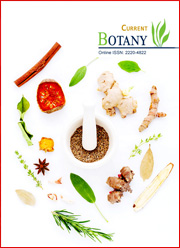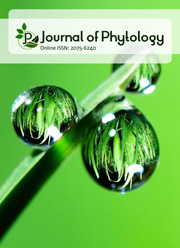Morphological screening of rice varieties growing in Assam resistance to aluminium toxicity
DOI:
https://doi.org/10.25081/cb.2025.v16.9307Keywords:
Abiotic stress, Aluminium toxicity, Growth, RiceAbstract
When plants are exposed to low pH levels, aluminium, which is unnecessary for plant growth, can be harmful. This experiment was conducted to study the aluminium toxicity induced responses among the 100 rice varieties growing in Assam, India. The rice seeds were grown hydroponically in Hoagland’s solution and 10 day old seedlings were subjected to 50 and 100μMAlCl3 treatment for 7 days and various growth parameters (viz., root length, shoot length, root fresh weight, shoot fresh weight, root dry weight, shoot dry weight) were recorded. Based on the overall morphological parameters, the aluminium Stress Response Index (SRI) was calculated. Again, iPASTIC software is also used to calculate various tolerance indices. Our experiment identified the Al-tolerant and Al-sensitive rice varieties based on the growth performance. Our findings lead us to conclude that both the Stress Response Index and iPASTIC can be used as a useful method for sorting among a wide range of rice cultivars to assess each variety’s resistance to a particular abiotic stress.
Downloads
References
Ali, B., Hasan, S. A., Hayat, S., Hayat, Q., Yadav, S., Fariduddin, Q., & Ahmad, A. (2008). A role for brassinosteroids in the amelioration of aluminium stress through antioxidant system in mung bean (Vigna radiata L. Wilczek). Environmental and Experimental Botany, 62(2), 153-159. https://doi.org/10.1016/j.envexpbot.2007.07.014
Alvarez, I., Sam, O., Reynaldo, I., Testillano, P., Risueño, M. C., & Arias, M. (2012). Morphological and cellular changes in rice roots (Oryza sativa L.) caused by Al stress. Botanical Studies, 53, 67-73.
Anwaar, H. A., Perveen, R., Mansha, M. Z., Abid, M., Sarwar, Z. M., Aatif, H. M., ud din Umar, U., Sajid, M., Aslam, H. M. U., Alam, M. M., Rizwan, M., Ikram, R. M., Alghanem, S. M. S., Rashid, A., & Khan, K. A. (2020). Assessment of grain yield indices in response to drought stress in wheat (Triticum aestivum L.). Saudi Journal of Biological Sciences, 27(7), 1818-1823. https://doi.org/10.1016/j.sjbs.2019.12.009
Bressan, A. C. G., de Oliveira Carvalho Bittencourt, B. M., Silva, G. S., & Habermann, G. (2021). Could the absence of aluminum (Al) impair the development of an Al-accumulating woody species from Brazilian savanna? Theoretical and Experimental Plant Physiology, 33, 281-292. https://doi.org/10.1007/s40626-021-00216-y
de Freitas, L. B., Fernandes, D. M., Maia, S. C. M., & Fernandes, A. M. (2017). Effects of silicon on aluminum toxicity in upland rice plants. Plant and Soil, 420, 263-275. https://doi.org/10.1007/s11104-017-3397-4
Etminan, A., Pour‐Aboughadareh, A., Mohammadi, R., Shoshtari, L., Yousefiazarkhanian, M., & Moradkhani, H. (2019). Determining the best drought tolerance indices using artificial neural network (ANN): Insight into application of intelligent agriculture in agronomy and plant breeding. Cereal Research Communications, 47, 170-181. https://doi.org/10.1556/0806.46.2018.057
Guttieri, M. J., Stark, J. C., O'Brien, K., & Souza, E. (2001). Relative sensitivity of spring wheat grain yield and quality parameters to moisture deficit. Crop science, 41(2), 327-335. https://doi.org/10.2135/cropsci2001.412327x
Kalita, J., & Tanti, B. (2020). Screening of some traditional rice cultivars of Assam, India, for their response to arsenic-induced abiotic stress. Acta Agrobotanica, 73(1), 7315. https://doi.org/10.5586/aa.7315
Khalili, M., Pour-Aboughadareh, A., & Naghavi, M. R. (2016). Assessment of drought tolerance in barley: integrated selection criterion and drought tolerance indices. Environmental & Experimental Biology, 14, 33-41. https://doi.org/10.22364/eeb.14.06
Pour‐Aboughadareh, A., Yousefian, M., Moradkhani, H., Vahed, M. M., Poczai, P., & Siddique, K. H. M. (2019). iPASTIC: An online toolkit to estimate plant abiotic stress indices. Applications in Plant Sciences, 7(7), e11278. https://doi.org/10.1002/aps3.11278
Pradhan, A. K., Shandilya, Z. M., Sarma, P., Bora, R. K., Regon, P., Vemireddy, L. N. R., & Tanti, B. (2023). Concurrent effect of aluminum toxicity and phosphorus deficiency in the root growth of aluminum tolerant and sensitive rice cultivars. Acta Physiologiae Plantarum, 45, 33. https://doi.org/10.1007/s11738-022-03509-0
Rahman, R., & Upadhyaya, H. (2021). Aluminium toxicity and its tolerance in plant: A review. Journal of Plant Biology, 64, 101-121. https://doi.org/10.1007/s12374-020-09280-4
Rasheed, A., Wassan, G. M., Khanzada, H., Solangi, A. M., Han, R., Li, H., Bian, J., & Wu, Z. (2021). Identification of genomic regions at seedling related traits in response to aluminium toxicity using a new high-density genetic map in rice (Oryza sativa L.). Genetic Resources and Crop Evolution, 68, 1889-1903. https://doi.org/10.1007/s10722-020-01103-2
Rosmaninho, L. B. de C., Dias, L. A. S., da Silva, M. F., Vasconcelos, A. de A., Santos, W. O., Perez, C. E. A., Vergutz, L., & Cardoso, L. G. (2019). Performance of Crambe submitted to aluminum stress: An important oilseed plant. Journal of Agricultural Science, 11(2), 454. https://doi.org/10.5539/jas.v11n2p454
Samad, R., Rashid, P., & Karmoker, J. L. (2021). Effects of aluminium toxicity on root and shoot growth of rice and chickpea seedlings. Bangladesh Journal of Botany, 50(4), 1195-1201. https://doi.org/10.3329/bjb.v50i4.57089
Sardouei‐Nasab, S., Mohammadi‐Nejad, G., & Nakhoda, B. (2019). Yield stability in bread wheat germplasm across drought stress and non‐stress conditions. Agronomy Journal, 111(1), 175-181. https://doi.org/10.2134/agronj2018.06.0381
Shandilya, Z. M., & Tanti, B. (2019). Hydroponic screening of traditional rice varieties in Assam, India to estimate their potential resistance to Al toxicity under P deficiency. Acta Agrobotanica, 72(4), 1793. https://doi.org/10.5586/aa.1793
Sun, L., Zhang, M., Liu, X., Mao, Q., Shi, C., Kochian, L. V., & Liao, H. (2020). Aluminium is essential for root growth and development of tea plants (Camellia sinensis). Journal of Integrative Plant Biology, 62(7), 984-997. https://doi.org/10.1111/jipb.12942
Yan, L., Riaz, M., Liu, J., Liu, Y., Zeng, Y., & Jiang, C. (2021). Boron reduces aluminum deposition in alkali-soluble pectin and cytoplasm to release aluminum toxicity. Journal of Hazardous Materials, 401, 123388. https://doi.org/10.1016/j.jhazmat.2020.123388
Published
How to Cite
Issue
Section
Copyright (c) 2025 Runa Rahman, Safiqul Hussain, Hrishikesh Upadhyaya

This work is licensed under a Creative Commons Attribution-NonCommercial 3.0 Unported License.



 .
.